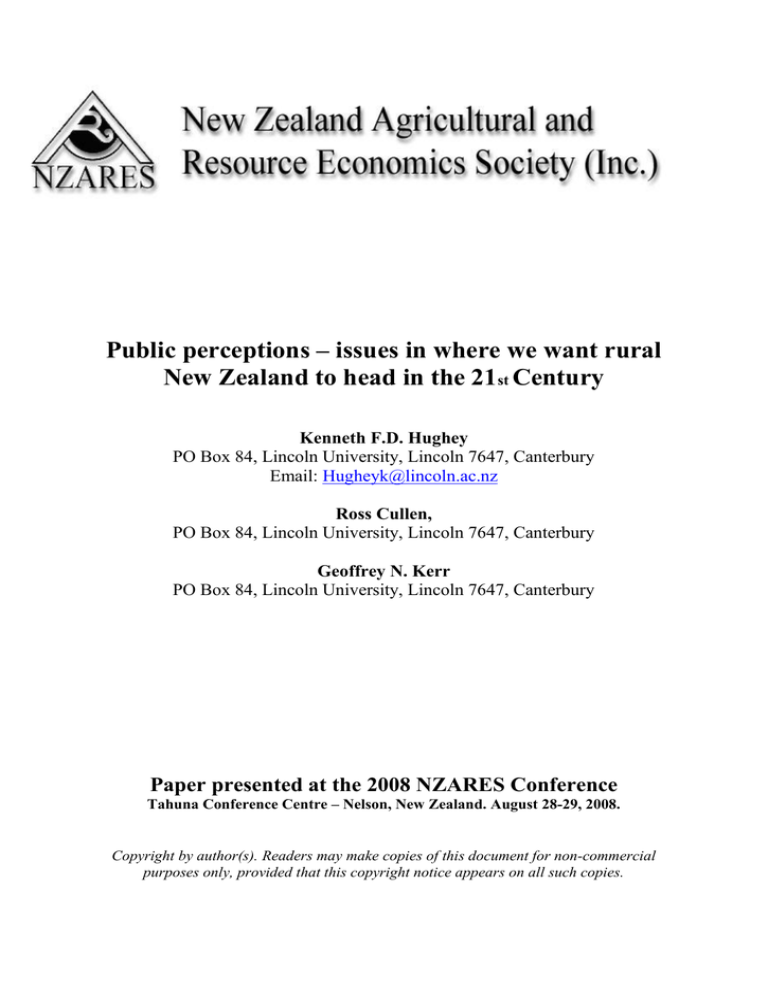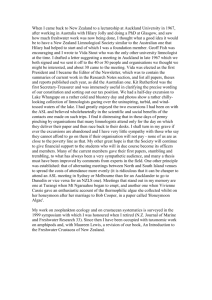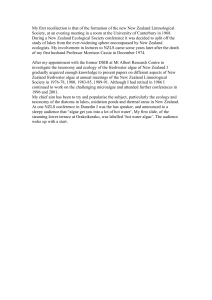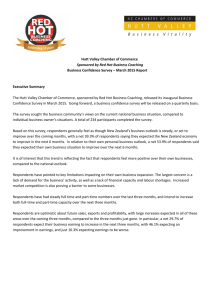Public perceptions – issues in where we want rural Century
advertisement

Public perceptions – issues in where we want rural New Zealand to head in the 21st Century Kenneth F.D. Hughey PO Box 84, Lincoln University, Lincoln 7647, Canterbury Email: Hugheyk@lincoln.ac.nz Ross Cullen, PO Box 84, Lincoln University, Lincoln 7647, Canterbury Geoffrey N. Kerr PO Box 84, Lincoln University, Lincoln 7647, Canterbury Paper presented at the 2008 NZARES Conference Tahuna Conference Centre – Nelson, New Zealand. August 28-29, 2008. Copyright by author(s). Readers may make copies of this document for non-commercial purposes only, provided that this copyright notice appears on all such copies. Public perceptions – issues in where we want rural New Zealand to head in the 21st Century Kenneth F.D. Hughey*, Ross Cullen, Geoffrey N. Kerr PO Box 84, Lincoln University, Lincoln 7647, Canterbury *Corresponding author contact details: PO Box 84, Lincoln University, Lincoln 7647, Canterbury; Email: Hugheyk@lincoln.ac.nz Summary The ongoing biennial environmental perceptions survey has been used to consider issues when setting future directions for rural New Zealand in the 21st Century. The overall state of the environment is very good, although freshwater rates the lowest of all resources considered. At a more local level there is considerable concern about lowland streams, rivers and lakes. Farming is increasingly blamed for damaging freshwater and a range of other resources. There are important demographic differences. Those employed in resource based industries are much more positive about specific water resources than are others – anglers are more pessimistic. New Zealanders want an improved future for the rural environment and are willing to contribute. Achieving sustainability would have multiple benefits and would arguably come at only one cost, a higher cost of living. Key words: perception surveys; rural futures; issues Introduction Defining what the public thinks – where do we want to go with rural NZ in the 21st century? – is not easy. There are multiple reasons why this is not an easy task, especially in relation to the environment. Notable reasons are: 1. We all construct our views of the environment and futures from different contexts – generally farmers are likely to have different views than will urban-based members of conservation organisations – identifying, understanding and reconciling these views is extremely challenging; 2. There has been no consensus building, integrating or strategic planning approach in New Zealand to identify such a desired future. Given the nature of this issue and its underlying challenges, the use of public surveys is one approach to identifying where we want to go with rural NZ in the 21st century. In this paper we give a brief overview of relevant surveys and identify some strengths and weaknesses from this sort of approach. We then introduce our biennial survey of peoples’ perceptions of the New Zealand environment as one vehicle for trying to make sense of where we might want to go: • Priorities for the government and for individual New Zealanders • Pressures, state and responses – focused on the rural environment • What sustainability would achieve for New Zealand. At the end of each of these sections a conclusions and implications ‘box’ is presented. Based on these we then consider what New Zealanders do not want, and do want, and then draw some conclusions. Overview of key environmental surveys in New Zealand There have been multiple environment-related surveys undertaken by or on behalf of central government departments, local authorities, by NGOs, by business groups, and many by researchers. Many are descriptive and few truly analytical. Amongst the best known, relevant, surveys are: • Environment Waikato’s now triennial surveys (e.g., Gravitas Research and Strategy Ltd 2007) - The Environmental Awareness, Attitudes and Action Survey was first undertaken by Environment Waikato in June 1998 to benchmark environmental perceptions within the region, and repeated in 2000, 2003 and 2006. • Environment Bay of Plenty’s triennial surveys (e.g., Key Research 2007) started in 2003. • The Lincoln University biennial survey of peoples’ perceptions of the NZ environment (5 surveys from 2000, e.g., Hughey et al. 2006; 2008 in prep.). • Growth and Innovation Advisory Board (2004): national vs individual preferences for environment, growth, education, etc. There are multiple related surveys but most lack depth of relevant questioning, analysis, and national level application. Only the ongoing Lincoln University based survey provides a context for assessing national (and regional depending on response rate) level perceptions and changes of these over time – it therefore forms the basis for the detailed discussion that follows. 2 The biennial survey of peoples’ perceptions of the NZ environment The survey assesses people’s perceptions of the state of the NZ environment with respect to 11 natural resources: • Natural environment in towns and cities; • Air; • Native land and freshwater plants and animals; • Native bush and forests; • Soils; • Coastal waters and beaches; • Marine fisheries; • Rivers and lakes; • Groundwater; • Wetlands; and • Natural environment compared to other developed countries. It is built around the Pressure-State-Response (OECD, 1999) model of environmental reporting, i.e., pressures on resources, state of resources and management of resources and problems associated with them. As far as we know, this is the first and only survey of its type to adopt this model. A postal questionnaire was selected as the best method of gathering this information. The large number of questions deemed it unsuitable for a telephone survey and interviews would have been an expensive and cumbersome method for sampling the New Zealand population. Two thousand people aged 18 and over are randomly selected from the Electoral Roll. Demographic variables include: age, gender, region, ethnicity, education, and employment sector. Response rates have been high for all years1. Data are analysed descriptively and, where applicable, the 2008 survey responses have been compared with 2006, 2004, 2002 and 2000 surveys. Each of our surveys asks an additional set of questions focused on one (and sometimes more) topic area: • 2000 natural hazards and preparedness; • 2002 coastal management and marine recreational fishing; • 2004 freshwater management and recreational fishing; • 2006 land transport and their externalities, priorities for New Zealanders; • 2008 conservation, recreation, freshwater. In this paper we present general results from the five surveys and specific results from the 2004 and 2008 freshwater case studies, and the 2008 recreational activities question, as our means of evaluating what people want for rural futures in New Zealand, and for identifying some of the key issues surrounding these wants. Priorities for the government and for individual New Zealanders Our 2006 survey included a case study on priorities for the government and for individuals. Questions were designed around evaluating priorities for the environment compared to other key activities including income, defence, health, law enforcement 1 Effective survey response rates: 2000-48%, 2002-45%, 2004-43%, 2006-46%, 2008-40%. 3 and education. Figure 1 shows peoples’ individual highest priority for government action – the economy, health and education were the top priorities. Figure 1. Priorities for the NZ government - 2006 (source: Hughey et al. 2006). A strong defence system A fair level of supperannuation and income support A low crime rate A high quality environment A high quality education system A high quality health system A strong economy 0 5 10 15 20 25 30 Percent of respondents Each of the individual priorities was re-evaluated in terms of ordered average rankings, using a scale of 1 (highest priority) to 7 (lowest priority). When combined the revised order of priorities was: • a high quality health system 2.29 = Highest priority • a high quality education system 2.67 • a strong economy 3.14 • a high quality environment 3.97 • a low crime rate 4.43 • a fair level of superannuation and income support 5.08 • a strong defence system 6.17 = Lowest priority While a strong economy was the most commonly chosen top priority, when mean priority rankings are calculated for each item the economy rates third, with quality of the environment in fourth position. The national level priorities for the government can be compared to individual priorities. Average Likert scores, on a scale of 1 (very important) to 5 (very unimportant), ranked from top to bottom, are listed below: • Quality of life 1.18 = Most important • Public health system 1.46 • Quality of education 1.50 • Quality of the natural environment 1.55 • Crime prevention 1.60 • Level of wages and salaries 1.85 • Level of economic growth 1.89 = Least important As with the Growth and Innovation Advisory Board (2004), this survey shows that quality of life and quality of the natural environment are more important than either 4 the level of wages and salaries, or the level of economic growth. Health and education both outrank the environment. In an attempt to compare the two surveys we have combined ‘very important’ and ‘important’ ratings, giving: Quality of life Quality of education Quality of natural environment The public health system Level of wages and salaries Level of economic growth Growth and Innovation Advisory Board (2004) 93% 83% 87% 78% 67% 67% This survey 99% 95% 95% 94% 84% 81% Our 2006 survey ranked New Zealand’s performance against the same attributes. Average Likert scores, on a scale of very good (1) to very bad (5), ranked from top to bottom, are listed below: • Quality of life 2.07 = Best performance • Quality of the natural environment 2.35 • Quality of education 2.57 • Level of economic growth 2.92 • Performance in the public health system 3.15 • Level of wages and salaries 3.17 • Crime prevention 3.50 = Worst performance Only crime prevention performance was considered overall to be less than adequate, with quality of the natural environment and quality of life both considered ‘good’. Box 1. Priorities for the government and for individual New Zealanders: the key messages. Key priorities for the government are the economy, health and education, followed by the environment. For individuals the priorities are different and the environment and quality of life are more important drivers than economic considerations. Pressures, states and responses – focused on the rural environment Pressures We asked people what the most important environmental issues were that New Zealand and the world face (Figure 2). For New Zealand water pollution was the most important issue (being identified by around 14% of respondents), while for the world it was global warming/climate change (around 32% of respondents). It is notable that around 26% of respondents chose a water-related issue for New Zealand. Two other relevant pieces of data are relevant here. First, and as shown in Table 1, data from our 2008 survey question about outdoor recreational activities shows that 40.8% of 5 respondents undertook freshwater based fishing, boating or waterfowl hunting in the previous year (clearly also excluding freshwater swimming and picnicking beside freshwaters). Second, and while not directly comparable, chapter downloads from the MfE website of Environment 2007 report show the level of interest in water as 26% chose the freshwater chapter with the next closest being biodiversity at 12% (MfE 2008: 3). Figure 2: Most important environmental issue in NZ and the World – 2008 (Source: Hughey et al. in prep.) Agriculture World New Zealand Urban sprawl/development Sustainable management of resources Global warming/climate change/ ozone layer Air pollution/air quality Dispoasal of refuse'waste Pollution (unspecified) Water (unspecified) Water use Water pollution Other 0 5 10 15 20 25 30 35 Percent of respondents Table 1: Respondent participation in a freshwater recreation activity over the previous year (N=752) Freshwater activity Fishing Boating Water Fowl Hunting Any of these activities Percent participating 16.9% 32.8% 4.8% Number of respondents 127 247 36 95% confidence intervals 14.2-19.6% 29.5-36.2% 3.3-6.3% 40.8% 307 37.3-44.3% Causes of damage to natural resources were also evaluated. Responses have been monitored from 2000 in terms of identifying the main causes of damage to freshwater (Figure 3). From 2000-2008 there was a significant increase in the proportion of respondents identifying farming as one of the main causes of damage. 6 Figure 3: Main causes of damage to freshwater (2000-2008) (Source: Hughey et al. in prep.) Forestry 2000 2002 2004 2006 2008 Tourism Mining Urban development Pests and weeds Household waste and emissions Dumping of solid waste Farming Industrial activities Hazardous chemicals Sewage and stormwater 0 10 20 30 40 50 Percent of respondents We have further analysed the 2008 responses and found a significant difference between ethnic groups in their perceptions of and causes of damage to freshwater. Notably, New Zealand European respondents have a much greater level of concern than do Maori or other ethnicities, concerning damage caused by farming and dumping of solid waste (Figure 4). Figure 4: Main causes of damage to freshwater by ethnicity - 2008 (Source: Hughey et al. in prep.) Urban development Maori NZ European Other Household waste and emissions Pests and weeds Dumping of solid waste Industrial activities Farming Sewage and storm water Hazardous chemicals 0 20 40 60 Percent of respondents State The public have overall positive views about the state or condition of New Zealand resources (Figure 5) with only rivers and lakes, and marine fisheries, having any significant negative ratings. 7 Figure 5: The state of New Zealand resources in 2008 (Source: Hughey et al. in prep.) Rivers and lakes Don't know % 5 Marine fisheries 13 Wetlands 15 Groundwater 13 Natural environment in towns and cities 2 Negative Positive 8 Soils Native land and freshwater plants and animals 4 Coastal waters and beaches 3 Air 1 Native bush and forests 3 NZ natural environment compared to other developed countries 5 -40 -20 0 20 40 60 80 100 Percentage of respondents Very bad Adequate Good Bad Very good While the overall positive rating for freshwater aligns with biophysical scientific assessment at the national level, it is countered by assessments of lowland streams and lakes (see for example Larned et al. 2003, Parkyn & Wilcock 2004) which indicate poor quality of water and often significantly reduced flows. Survey respondents were presented with a variety of statements about rivers, streams and lakes (Figure 6, and see Hughey et al. 2004, Cullen et al. 2006, and Hughey et al. 2007 for further examples and analysis), and responses were supportive of the science findings, i.e., people think lowland streams in their region have low water quality. Figures 7 and 8 show different perceptions based on demographics – respectively, those working in resource based industries have positive views while others (the majority of respondents) are negative; anglers (38% of all respondents, Hughey et al. 2004) are more concerned about damage to large rivers than are non anglers. 8 Figure 6: ‘Small lowland streams in my region have high water quality’ (2004, 2008) 35 2004 2008 30 Percent response 25 20 15 10 5 0 Strongly agree Figure 7: Agree Neither Disagree Stongly disagree Small lowland streams in my region have high water quality - 2004 Don't know % negative positive Total sample 30 Resource based 21 Other 31 -40 Stongly disagree Figure 8: Don't know -20 0 20 Percent of respondents Disagree Neither 40 Agree Strongly agree More water should be taken from large rivers for irrigation even if it has a negative impact on freshwater fisheries - 2004 negative positive Total sample Don't know % 11 Non angler 14 Angler 5 -60 Stongly disagree -40 -20 0 20 Percent of respondents Disagree Neither 40 Agree Strongly agree 9 Response A variety of question types have been used to evaluate management response and its adequacy. Analysis of Figure 9 shows that most respondents do not consider lowland streams in their region to be well managed – a comparison between 2004 and 2008 indicates a consistent pattern of perception. Interestingly (Figure 10), there are major differences in perceptions amongst two key user groups, namely those employed in resource based industries and others, and freshwater anglers and non anglers. Figure 9: Small lowland streams in my region are well managed (2004, 2008) 35 2004 2008 30 Percent response 25 20 15 10 5 0 Strongly agree Figure 10: Agree Neither Disagree Stongly disagree Don't know Small lowland streams in my region are well managed - 2004 negative Total sample positive Don't know % 32 Resource based 17 Other 34 Non angler 41 Angler 19 -40 Stongly disagree -20 0 20 40 60 Percent of respondents Disagree Neither Agree Strongly agree In our 2004 survey we asked respondents about their willingness to pay for lowland stream enhancement work (Figure 11). Over half of respondents were willing to pay a targeted rate for this purpose. 10 Figure 11: Willingness To Pay $20 per year in additional rates for 10 years to pay for lowland stream enhancement work (Source: Hughey et al. 2004) Percent of respondents (%) 50 40 30 20 10 0 Strongly Supportive supportive Don't Care Opposed Strongly opposed Don't know Followup open-ended explanations were evaluated. Those supportive or strongly supportive of a $20 rate increase made comments like: • ‘Small price to pay for the common good’ (43% of 484 responses); followed by: • ‘Good to pass onto future generations’; • ‘To clean up the water’; and • ‘Better than cleaning it up later’. Those opposed or strongly opposed said: • ‘rates are too high already’ (23% of 484 responses); • ‘industry or farmers should pay for this, not ratepayers’; or • ‘no proof projects are being done efficiently’ and ‘on a low income’. Box 2. Pressures, states and responses – focused on the rural environment: the key messages The overall state of the New Zealand environment is very good, although freshwater, of all resources considered, rates the lowest. At a more local level there is considerable concern about lowland streams, rivers and lakes. The key pressures on these resources are human-induced. Farming is increasingly blamed for damaging freshwater but also for damage to a range of other resources. Freshwater related issues are the single biggest environmental concern for New Zealanders. There are important demographic differences. Those employed in resource based industries are much more positive about the state of specific water resources than are others – anglers are more pessimistic. Management of lowland streams is considered inadequate but people are willing to pay for on the ground actions to improve lowland streams. 11 What sustainability would achieve Respondents were asked about the effect on New Zealand of achieving environmental sustainability (Figure 12). There was only one negative impact, and that was achieving sustainability would not lower living costs. Six other measures were assessed very positively. Figure 12: ‘Achieving environmental sustainability in NZ would …’ – 2006 (Source: Hughey et al. 2006) Negative Don't know Positive % Reduce climate change impacts 8 Enhance NZ's clean green image 3 Reduce pressure on limited resources 6 Ensure access to recreational resources 5 Lower living costs 8 Improve quality of life 3 Enhance economic growth 7 -40 -20 0 20 40 60 80 100 120 Percentage of respondents Strongly disagree Disagree Neither disagree nor agree Agree Strongly agree When mean Likert scores were calculated, using a scale of 1 (strongly agree) to 5 (strongly disagree), the following rankings from top to bottom, occurred: • Enhance NZ's clean green image 1.65 = Most likely • Improve quality of life 1.94 • Ensure access to recreational resources 2.04 • Reduce pressure on limited resources 2.08 • Enhance economic growth 2.30 • Reduce climate change impacts 2.33 • Lower living costs 2.94 = Least likely Even for lower living costs, the lowest ranked of these implications, the average response remains positive. Box 3. What sustainability would achieve: the key messages. Achieving sustainability would have multiple benefits for New Zealand and would arguably come at only one cost, a possibility of higher living costs. 12 Overall discussion and conclusions Three main sets of messages can be learnt from this analysis. First, while the government’s main concerns should be with health, education and the economy, individuals place higher priorities on quality of life and quality of the environment. Secondly, given this level of individual interest in, and the high overall rating of the state of the New Zealand environment, there is considerable concern about the quality and management of lowland streams and an increasing amount of blame is being placed on farming for damage to freshwaters. Finally, and perhaps in terms of providing a lead for thinking about rural futures, there is the overall view that achieving sustainability in New Zealand would bring multiple benefits. These sets of key messages lead us to the following views, based on our survey research: • People ‘don’t want’ development to wreck rivers, streams, lakes, etc. – they recreate in and value these resources highly; • Farming is increasingly a cause of damage to the environment – it should not be permitted to do this; • People are worried about freshwater, its management and pollution; and • Given that individual and government priorities place a high emphasis on the environment, (and noting that individuals are willing to pay for improvements and/or mitigation where key rural resources are damaged), it is clear that rural land development/intensification needs to occur with sustainability as a requirement, and not afterwards as a fix (and perhaps only a partial fix) solution. There is an important challenge that arises from these conclusions. The challenge is how to match political response, and policy development to the level of public concern about the rural environment and its component parts. Goals are to ensure that New Zealand land-users employ sustainable practices and rural New Zealand delivers a range of sought after ecosystem services. REFERENCES Cullen, R., Hughey, K.F.D. and Kerr, G.N. (2006). New Zealand fresh water management and agricultural impacts. The Australian Journal of Agricultural and Resource Economics, 50: 327-346. Gravitas Research and Strategy Ltd. (2007). Environmental Awareness, Attitudes and Actions, 2006. A survey of residents of the Waikato Region. Environment Waikato Technical Report 2007/06, Environment Waikato, Hamilton. Growth and Innovation Advisory Board. (2004). Research Summary. Ministry of Research, Science and Technology, Wellington. Hughey, K.F.D., Kerr, G.N. and Cullen, R. (2004). Public Perceptions of New Zealand's Environment: 2004. EOS Ecology, Christchurch. Hughey, K.F.D., Kerr, G.N. and Cullen, R. (2006). Public perceptions of New Zealand’s Environment: 2006. EOS Ecology: Christchurch. 13 Hughey, K.F.D., Kerr, G.N. and Cullen, R. (2007). Public perceptions of New Zealand freshwater and its management – reconciling the science and management implications. Australasian Journal of Environmental Management, 14(2): 82-92. Key Research. (2007). Attitudes and Perceptions towards the environment and Environment Bay of Plenty 2006. Strategic Policy Publication 2007/01. Environment Bay of Plenty, Rotorua. Larned, S.T., Scarsbrook, M., Snelder, T. and Norton, N. (2003). Nationwide and Regional State trends in river water quality 1996-2002. NIWA client report. CHC2003-O51. Prepared for the Ministry for the Environment, NIWA, Christchurch. Ministry for the Environment (MfE). (2007). Environment New Zealand 2007. MfE, Wellington. Ministry for the Environment. (2008). Environmental Indicators Quarterly. Issue 1, Winter 2008. Ministry for the Environment, Wellington. Organisation for Economic Co-Operation and Development (OECD). (1999). Using the Pressure-State-Response Model to Develop Indicators of Sustainability: OECD Framework for Environmental Indicators. Retrieved 20 November 2002: http://euroconfql.arcs.ac.at/Event1/Keynotes_panel/Keynote5-Fletcher.html Parkyn, S. and Wilcock, B. (2004) Impacts of Agricultural Land Use. In: Harding, J., Mosley, M., Pearson, C, and Sorrell, B. (eds). Freshwaters of New Zealand. Chapter 34.1-16, New Zealand Hydrological Society, Christchurch. 14






